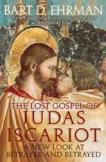Part of the Divine Plan?
These academic and popularizing skills brought him the invitation to be part of a top secret group of consultants to the National Geographic Society for the purpose of deciding whether or not to invest in publishing a fourth-century book that contains the Gospel of Judas. He describes the hush, hush trip to Geneva and his first glimpses of this work in a studio over a pizza shop. By now readers have seen the clips of the panel, photos and the rest of the publicity that went with the official rollout in the spring of 2006. The National Geographic Society published a book by Herb Krosney (The Lost Gospel: The Search for the Gospel of Judas), which tells the story of illegal looting, attempts to sell, mutilation and years rotting in a safe deposit box until the book was acquired by an antiquities dealer, Frieda Tchacos Nussberger. Professor Ehrman hopes to interest general readers in a part of our story that is too little known. But apart from his personal reactions, he does not add to Krosney’s version of events.
Perhaps the lack of additional insight stems from the web of secrecy still attached to this codex. Some of the other parties have made conflicting statements about what they saw and when. In addition, Ms. Nussberger has been mentioned in connection with looted antiquities purchased by the Getty Museum. Either Ehrman is not aware of the conflicting stories or has chosen to adopt the official line.
Ehrman is not expert in the language of this gospel (Coptic) or in the study of Gnostic revelation dialogues, the type of early Christian writing found in Codex Tchacos. He depends upon the published English translation and the work of specialists in Gnosticism. As a scholar of early Christian manuscripts, he should have asked himself what the other writings copied into the codex tell us about its interpretation. Although the Gospel of Judas presents Judas as the only disciple who understands Jesus’ teaching, the collection undermines that perspective. The first text, The Letter of Peter to Philip, invokes a picture of the Twelve led by Peter much like the opening of Acts. After the resurrection and ascension of Jesus, Peter assembles the Twelve. They come to learn true Gnostic wisdom about the crucifixion of Jesus and go forth to preach it to the world. The second, First Apocalypse of James, has James, the brother of the Lord, receive similar enlightenment from Jesus. Consequently, the wisdom exhibited by Judas was not his aloneat least not for those who compiled and read the book that contains the Gospel of Judas.
Ehrman warns readers that the Gospel of Judas provides no reliable first-century information about the historical Jesus or the historical Judas. So much for the promise in the subtitle of his new book. Much of The Lost Gospel of Judas Iscariot repackages Ehrman’s earlier work on early Christian writings that were never Christian Scripture. It describes the different portraits of Judas in the New Testament, in these later writings and in comments by early Christian writers. Ehrman admits that in the Gospel of Judas Judas is not a character with personality, emotions or motives. He is a figure in a revelation dialogue. Unlike the other disciples, Judas understands Jesus’ teaching about his inner, divine nature and the need to abandon attachment to empty sacrificial rites. As in other Gnostic revelations, the enlightened disciple can expect persecution from those who are not so enlightened. For Judas that comes in a dream vision, in which he is being stoned by the Twelve before entering a vast heavenly house, the dwelling of the angelic elect.
Whether or not such motifs reflect hostility toward orthodox Christianity, as Ehrman assumes, can be questioned. The passage refers to an astral destiny, which misleads humansa Gnostic theology of fate. Nor does an enlightened being like Jesus need the assistance of Judas to secure liberation from the material body. Ehrman’s claim that Judas serves Jesus by betraying him has no basis in the text. In fact, as Ehrman pointed out when discussing the canonical gospels, the nature of Judas’s betrayal is quite fuzzy in the early Christian mind. As in the canonical gospels, Judas points out the place where Jesus is assembled, apparently with the Twelve. At that point the Gospel of Judas ends.
It is an odd ending. Ehrman explains that gospel of means gospel about Judas rather than according tothat is, the text is about Judas talking about Jesus. The opening of the Gospel of Judas, however, says it is a secret account of revelation Jesus gave to Judas before his Passion. The gospel of title is a scribal addition to identify the writing in a collection. The Gospel of Judas is one more glimpse into the diversity of belief and imagination in early Christianity.
This article also appeared in print, under the headline “Part of the Divine Plan?,” in the February 5, 2007, issue.








